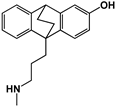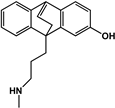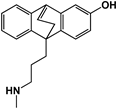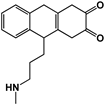Comparison of Advanced Oxidation Processes for the Degradation of Maprotiline in Water—Kinetics, Degradation Products and Potential Ecotoxicity
Abstract
1. Introduction
2. Results
2.1. Maprotiline Photoinduced Degradation
2.2. Maprotiline Transformation Products
2.3. In Silico Bioassays
3. Discussion
4. Materials and Methods
4.1. Chemicals
4.2. Preparation of Catalysts
4.2.1. Fe(0.5%)ZnO and Ce(1%)ZnO
4.2.2. Fe3O4/HA
4.3. Methods
4.3.1. Photodegradation Experiments under UVA Irradiation
4.3.2. Analysis
4.3.3. In-Silico Bioassays
5. Conclusions
Supplementary Materials
Author Contributions
Funding
Data Availability Statement
Conflicts of Interest
References
- Taheran, M.; Naghdi, M.; Brar, S.K.; Verma, M.; Surampalli, R.Y. Emerging contaminants: Here today, there tomorrow! Environ. Nanotechnol. Monit. Manag. 2018, 10, 122–126. [Google Scholar] [CrossRef]
- Petrie, B.; Barden, R.; Kasprzyk-Hordern, B. A review on emerging contaminants in wastewaters and the environment: Current knowledge, understudied areas and recommendations for future monitoring. Water Res. 2014, 72, 3–27. [Google Scholar] [CrossRef] [PubMed]
- Starling, M.C.V.M.; Amorim, C.C.; Leão, M.M.D. Occurrence, control and fate of contaminants of emerging concern in environmental compartments in Brazil. J. Hazard. Mater. 2019, 372, 17–36. [Google Scholar] [CrossRef]
- Ebele, A.J.; Abdallah, M.E.; Harrad, S. Pharmaceuticals and personal care products (PPCPs) in the freshwater aquatic environment. Emerg. Contam. 2017, 3, 1–16. [Google Scholar] [CrossRef]
- Das, S.; Ray, N.M.; Wan, J.; Khan, A.; Chakraborty, T.; Ray, M.B. Micropollutants in Wastewater: Fate and Removal Processes. In Physico-Chemical Wastewater Treatment and Resource Recovery; In Tech: Rijeka, Croatia, 2017; pp. 75–107. [Google Scholar]
- Lindberg, R.H.; Östman, M.; Olofsson, U.; Grabic, R.; Fick, J. Occurrence and behaviour of 105 active pharmaceutical ingredients in sewage waters of a municipal sewer collection system. Water Res. 2014, 58, 221–229. [Google Scholar] [CrossRef] [PubMed]
- Nguyen, T.T.; Westerhoff, P.K. Drinking water vulnerability in less-populated communities in Texas to wastewater-derived contaminants. NPJ Clean Water 2019, 2, 1–9. [Google Scholar] [CrossRef]
- Abbing-Karahagopian, V.; Huerta, C.; Souverein, P.C.; De Abajo, F.; Leufkens, H.G.M.; Slattery, J.; Alvarez, Y.; Miret, M.; Gil, M.; Oliva, B.; et al. Antidepressant prescribing in five European countries: Application of common definitions to assess the prevalence, clinical observations, and methodological implications. Eur. J. Clin. Pharmacol. 2014, 70, 849–857. [Google Scholar] [CrossRef] [PubMed]
- Bachmann, C.J.; Aagaard, L.; Burcu, M.; Glaeske, G.; Kalverdijk, L.J.; Petersen, I.; Schuiling-Veninga, C.C.; Wijlaars, L.; Zito, J.M.; Hoffmman, F. Trends and patterns of antidepressantuse in children and adolescents fromfivewestern countries, 2005–2012. Eur. Neuropsychopharmacol. 2016, 26, 411–419. [Google Scholar] [CrossRef]
- Ford, A.T.; Herrera, H. ‘Prescribing’ psychotropic medication to our rivers and estuaries. BJ Psych. Bull. 2019, 43, 147–150. [Google Scholar] [CrossRef]
- Vandermeersch, G.; Lourenço, H.M.; Alvarez-Muñoz, D.; Cunha, S.; Diogène, J.; Cano-Sancho, G.; Sloth, J.J.; Kwadijk, C.; Barcelo, D.; Allegaert, W.; et al. Environmental contaminants of emerging concern in seafood—European database on contaminant levels. Environ. Res. 2015, 143, 29–45. [Google Scholar] [CrossRef]
- Sehonova, P.; Svobodova, Z.; Dolezelova, P.; Vosmerova, P.; Faggio, C. Effects of waterborne antidepressants on non-target animals living in the aquatic environment: A review. Sci. Total Environ. 2018, 631–632, 789–794. [Google Scholar] [CrossRef] [PubMed]
- Martin, J.M.; Saaristo, M.; Tan, H.; Bertram, M.G.; Nagarajan-Radha, V.; Dowling, D.K.; Wong, B.B.M. Field-realistic antidepressant exposure disrupts group foraging dynamics in mosquitofish. Biol. Lett. 2019, 15, 20190615. [Google Scholar] [CrossRef]
- Loos, R.; Carvalho, R.; António, D.C.; Comero, S.; Locoro, G.; Tavazzi, S.; Paracchini, B.; Ghiani, M.; Lettieri, T.; Blaha, L.; et al. EU-wide monitoring survey on emerging polar organic contaminants in wastewater treatment plant effluents. Water Res. 2013, 47, 6475–6487. [Google Scholar] [CrossRef] [PubMed]
- Baresel, C.; Cousins, A.P.; Ek, M.; Ejhed, H.; Allard, A.-S.; Magnér, J.; Westling, K.; Fortkamp, U.; Wahlberg, C.; Hörsing, M.; et al. Pharmaceutical residues and other emerging substances in the effluent of sewage treatment plants. Review on concentrations, quantification, behaviour, and removal options. Swed. Environ. Res. Inst. Rep. B 2015, 2226. [Google Scholar]
- UNESCO; HELCOM. Pharmaceuticals in the Aquatic Environment of the Baltic Sea Region—A Status Report. UNESCO Emerging Pollutants in Water Series—No. 1; Minna, P.S.Z., Ed.; UNESCO Publishing: Paris, France, 2017; ISBN 9789231002137. [Google Scholar]
- Deng, Y.; Zhao, R. Advanced Oxidation Processes (AOPs) in Wastewater Treatment. Curr. Pollut. Rep. 2015, 1, 167–176. [Google Scholar] [CrossRef]
- Zhang, M.; Dong, H.; Zhao, L.; Wang, D.; Meng, D. A review on Fenton process for organic wastewater treatment based on optimization perspective. Sci. Total Environ. 2019, 670, 110–121. [Google Scholar] [CrossRef] [PubMed]
- Bokare, A.D.; Choi, W. Review of iron-free Fenton-like systems for activating H2O2 in advanced oxidation processes. J. Hazard. Mater. 2014, 275, 121–135. [Google Scholar] [CrossRef]
- Demarchis, L.; Minella, M.; Nisticò, R.; Maurino, V.; Minero, C.; Vione, D. Photo-Fenton reaction in the presence of morphologically controlled hematite as iron source. J. Photochem. Photobiol. A Chem. 2015, 307–308, 99–107. [Google Scholar] [CrossRef]
- Nosaka, Y.; Nosaka, A. Understanding Hydroxyl Radical (•OH) Generation Processes in Photocatalysis. ACS Energy Lett. 2016, 1, 356–359. [Google Scholar] [CrossRef]
- Nosaka, Y.; Nosaka, A.Y. Generation and Detection of Reactive Oxygen Species in Photocatalysis. Chem. Rev. 2017, 117, 11302–11336. [Google Scholar] [CrossRef] [PubMed]
- Barakat, M.A.; Kumar, R. Photocatalytic Activity Enhancement of Titanium Dioxide Nanoparticles; Springer International Publishing: Cham, Switzerland, 2016; ISBN 978-3-319-24269-9. [Google Scholar]
- Hu, K.; Li, R.; Ye, C.; Wang, A.; Wei, W.; Hu, D.; Qiu, R.; Yan, K. Facile synthesis of Z-scheme composite of TiO2 nanorod/g-C3N4 nanosheet efficient for photocatalytic degradation of ciprofloxacin. J. Clean Prod. 2020, 253, 120055. [Google Scholar] [CrossRef]
- Kumar, S.G.; Rao, K.S.R.K. Zinc oxide based photocatalysis: Tailoring surface-bulk structure and related interfacial charge carrier dynamics for better environmental applications. RSC Adv. 2015, 5, 3306–3351. [Google Scholar] [CrossRef]
- Paganini, M.C.; Giorgini, A.; Gonçalves, N.P.F.; Gionco, C.; Bianco Prevot, A.; Calza, P. New insight into zinc oxide doped with iron and its exploitation to pollutants abatement. Catal. Today 2019, 328, 230–234. [Google Scholar] [CrossRef]
- Gionco, C.; Paganini, M.C.; Giamello, E.; Burgess, R.; Di Valentin, C.; Pacchioni, G. Cerium-doped zirconium dioxide, a visible-light-sensitive photoactive material of third generation. J. Phys. Chem. Lett. 2014, 5, 447–451. [Google Scholar] [CrossRef]
- Gonçalves, N.P.F.; Minella, M.; Fabbri, D.; Calza, P.; Malitesta, C.; Mazzotta, E.; Bianco, A. Humic acid coated magnetic particles as highly e fficient heterogeneous photo-Fenton materials for wastewater treatments. Chem. Eng. J. 2020, 390, 124619. [Google Scholar] [CrossRef]
- Gonçalves, N.P.F.; Minella, M.; Mailhot, G.; Brigante, M.; Bianco Prevot, A. Photo-activation of persulfate and hydrogen peroxide by humic acid coated magnetic particles for Bisphenol A degradation. Catal. Today 2019, in press. [Google Scholar]
- Cory, W.C.; Welch, A.M.; Ramirez, J.N.; Rein, L.C. Naproxen and Its Phototransformation Products: Persistence and Ecotoxicity to Toad Tadpoles (Anaxyrus terrestris), Individually and in Mixtures. Environ. Toxicol. Chem. 2019, 38, 2008–2019. [Google Scholar] [CrossRef] [PubMed]
- Ellepola, N.; Ogas, T.; Turner, D.N.; Gurung, R.; Maldonado-Torres, S.; Tello-Aburto, R.; Patidar, P.L.; Rogelj, S.; Piyasena, M.E.; Rubasinghege, G. A toxicological study on photo-degradation products of environmental ibuprofen: Ecological and human health implications. Ecotoxicol. Environ. Saf. 2020, 188, 109892. [Google Scholar] [CrossRef] [PubMed]
- Boxall, A.B.A.; Sinclair, C.J.; Fenner, K.; Kolpin, D.; Maund, S.J. When Synthetic Chemicals Degrade in the Environment. Environ. Sci. Technol. 2004, 70, 368–375. [Google Scholar] [CrossRef]
- Salimi, M.; Esrafili, A.; Gholami, M.; Jonidi, J.A.; Rezaei, K.R.; Farzadkia, M.; Kermani, M.; Sobhi, H.R. Contaminants of emerging concern: A review of new approach in AOP technologies. Environ. Monit. Assess. 2017, 189, 414–436. [Google Scholar] [CrossRef] [PubMed]
- Chong, M.N.; Jin, B.; Chow, C.W.K.; Saint, C. Recent developments in photocatalytic water treatment technology: A review. Water Res. 2010, 44, 2997–3027. [Google Scholar] [CrossRef]
- Xu, X.; Pliego, G.; Zazo, J.A.; Liu, S.; Casas, J.A.; Rodriguez, J.J. Two-step persulfate and Fenton oxidation of naphthenic acids in water. J. Chem. Technol. Biotechnol. 2018, 93, 2262–2270. [Google Scholar] [CrossRef]
- Gonçalves, N.P.F.; Varga, Z.; Bouchonnet, S.; Dulio, V.; Alygizakis, N.; Bello, F.D.; Medana, C.; Calza, P. Study of the photoinduced transformations of maprotiline in river water using liquid chromatography high-resolution mass spectrometry. Sci. Total Environ. 2020, 755, 143556. [Google Scholar] [CrossRef]
- Suh, S.K.; Smith, J.B. Maprotiline Hydrochloride. Anal. Profiles Drug Subst. Excip. 1986, 15, 393–426. [Google Scholar]
- Blum, K.M.; Norström, S.H.; Golovko, O.; Grabic, R.; Järhult, J.D.; Koba, O.; Söderström Lindström, H. Removal of 30 active pharmaceutical ingredients in surface water under long-term artificial UV irradiation. Chemosphere 2017, 176, 175–182. [Google Scholar] [CrossRef] [PubMed]
- Nicol, E.; Xu, Y.; Varga, Z.; Kinani, S.; Bouchonnet, S.; Lavielle, M. SPIX: A new software package to reveal chemical reactions at trace amounts in very complex mixtures from high-resolution mass spectra data sets. Rapid Commun. Mass Spectrom. 2020, 35, e9015. [Google Scholar]
- Wells, B.G.; Pharm, D.; Gelenberg, A.J. Adverse Effects, and Efficacy of the Antidepressant Maprotiline Hydrochloride. Pharmacother. J. Hum. Pharmacol. Drug Ther. 1981, 1, 121–138. [Google Scholar] [CrossRef]
- Wu, S.; Fisher, J.; Naciff, J.; Laufersweiler, M.; Lester, C.; Daston, G.; Blackburn, K. Framework for identifying chemicals with structural features associated with the potential to act as developmental or reproductive toxicants. Chem. Res. Toxicol. 2013, 26, 1840–1861. [Google Scholar] [CrossRef]
- Paganini, M.C.; Dalmasso, D.; Gionco, C.; Polliotto, V.; Mantilleri, L.; Calza, P. Beyond TiO2: Cerium-Doped Zinc Oxide as a New Photocatalyst for the Photodegradation of Persistent Pollutants. ChemistrySelect 2016, 1, 3377–3383. [Google Scholar] [CrossRef]
- Hernández-Ramírez, A.; Medina-Ramírez, I. Photocatalytic Semiconductors; Springer International Publishing: Cham, Switzerland, 2015; ISBN 978-3-319-10998-5. [Google Scholar]
- Huie, R.E.; Clifton, C.L.; Neta, P. Electron tranfer reactions rates and equilibria of the carbonate and sulfate radical anions. Radiat. Phys. Chem. 1991, 38, 477–481. [Google Scholar]
- Gligorovski, S.; Strekowski, R.; Barbati, S.; Vione, D. Environmental Implications of Hydroxyl Radicals (•OH). Chem. Rev. 2015, 115, 13051–13092. [Google Scholar] [CrossRef]
- Neta, P.; Madhavan, V.; Zemel, H.; Fessenden, R.W. Rate Constants and Mechanism of Reaction of SO4 with Aromatic Compounds. J. Am. Chem. Soc. 1977, 99, 163–164. [Google Scholar] [CrossRef]
- Matzek, L.W.; Carter, K.E. Activated persulfate for organic chemical degradation: A review. Chemosphere 2016, 151, 178–188. [Google Scholar] [CrossRef]
- Ross, A.B.; Neta, P. Rate Constants for Reactions of Inorganic Radicals in Aqueous Solution. Natl. Bur. Stand. Natl. Stand. Ref. Data Ser. 1979, 17, 1027–1038. [Google Scholar]
- Yang, Z.; Su, R.; Luo, S.; Spinney, R.; Cai, M.; Xiao, R.; Wei, Z. Comparison of the reactivity of ibuprofen with sulfate and hydroxyl radicals: An experimental and theoretical study. Sci. Total Environ. 2017, 590–591, 751–760. [Google Scholar] [CrossRef]
- Technical Overview of Ecological Risk Assessment—Analysis Phase: Ecological Effects Characterization|Pesticide Science and Assessing Pesticide Risks|US EPA. Available online: https://www.epa.gov/pesticide-science-and-assessing-pesticide-risks/technical-overview-ecological-risk-assessment-0 (accessed on 25 November 2020).
- Minguez, L.; Farcy, E.; Ballandonne, C.; Lepailleur, A.; Serpentini, A.; Lebel, J.M.; Bureau, R.; Halm-Lemeille, M.P. Acute toxicity of 8 antidepressants: What are their modes of action? Chemosphere 2014, 108, 314–319. [Google Scholar] [CrossRef] [PubMed]
- Yakubu, A.M. Determination of lindane and its metabolites by HPLC-UV-Vis and MALDI-TOF. J. Clin. Toxicol. 2012, 71, 310–319. [Google Scholar] [CrossRef]
- Guler, Y.; Ford, A.T. Anti-depressants make amphipods see the light. Aquat. Toxicol. 2010, 99, 397–404. [Google Scholar] [CrossRef] [PubMed]
- Weinberger, J.; Klaper, R. Environmental concentrations of the selective serotonin reuptake inhibitor fluoxetine impact specific behaviors involved in reproduction, feeding and predator avoidance in the fish Pimephales promelas (fathead minnow). Aquat. Toxicol. 2014, 151, 77–83. [Google Scholar] [CrossRef]
- Benfenati, E.; Manganaro, A.; Gini, G. VEGA-QSAR: AI inside a platform for predictive toxicology. CEUR Workshop Proc. 2013, 1107, 21–28. [Google Scholar]


| Compound | [M+H]+ | Formula | ∆ | r.t. | TiO2 | Fe-ZnO | Ce-ZnO | Fe3O4/HA | |
|---|---|---|---|---|---|---|---|---|---|
| (ppm) | (min) | H2O2 | S2O82− | ||||||
| Maprotiline | 278.1911 | C20H24N | −2.81 | 9.7 | |||||
| 294-A (a) | 294.1858 | C20H24NO | −1.98 | 7.3 | + | + | + | + | - |
| 294-B (a) | 7.8 | + | + | + | + | + | |||
| 294-C (a) | 8.0 | + | + | + | + | + | |||
| 294-D | 8.3 | + | + | + | + | + | |||
| 294-E | 8.9 | + | + | + | + | + | |||
| 310-A | 310.1807 | C20H24NO2 | −2.00 | 6.9 | + | + | + | + | - |
| 310-B | 7.2 | + | + | + | + | - | |||
| 310-C | 7.4 | + | + | + | + | - | |||
| 310-D | 8.0 | + | + | + | + | + | |||
| 310-E | 8.2 | + | + | + | + | - | |||
| 310-F | 8.5 | + | + | + | + | + | |||
| 326-A | 326.1757 | C20H24NO3 | −2.13 | 6.1 | + | + | + | + | + |
| 326-B (a) | 6.9 | + | + | + | + | + | |||
| 326-C (a) | 7.6 | + | + | + | + | + | |||
| 342-A (a) | 342.1707 | C20H24NO4 | −2.09 | 6.0 | + | + | + | + | + |
| 342-B (a) | 6.4 | + | + | + | + | + | |||
| 342-C (a) | 7.1 | + | + | + | + | + | |||
| 342-D | 7.6 | + | + | + | + | + | |||
| 292-A | 292.1701 | C20H22NO | −2.06 | 6.9 | + | + | + | + | - |
| 292-B (a) | 7.9 | + | + | + | + | - | |||
| 292-C (a) | 8.5 | + | + | + | + | - | |||
| 292-D | 8.6 | + | + | + | + | - | |||
| 292-E | 9.1 | + | + | + | + | + | |||
| 308-A | 308.1651 | C20H22NO2 | −1.96 | 6.4 | + | + | + | + | - |
| 308-B (a) | 7.3 | + | + | + | + | - | |||
| 308-C (a) | 7.7 | + | + | + | + | + | |||
| 324-A | 324.1599 | C20H22NO3 | −1.70 | 5.8 | + | + | + | + | + |
| 324-B | 6.4 | - | - | - | - | + | |||
| 324-C | 7.0 | - | - | - | - | + | |||
| 324-D | 7.9 | - | - | - | - | + | |||
| 284-A | 284.1650 | C18H22NO5 | −1.75 | 6.7 | + | + | + | + | + |
| 284-B | 7.3 | + | + | + | + | + | |||
| 284-C (a) | 7.7 | + | - | - | + | + | |||
| 284-D | 8.4 | - | - | - | - | + | |||
| 234 (a) | 234.1492 | C14H20NO2 | −1.70 | 4.4 | + | + | + | + | + |
| 258 | 258.1493 | C16H20NO2 | −1.77 | 6.3 | + | + | - | + | + |
| Compound | Mutagenicity (AMES test) | Developmental/Reproductive Toxicity | F. Minnow LC50 (96 h) (mg L−1) | D. Magna LC50 (48 h) (mg L−1) | Fish Acute LC50 (48 h) (mg L−1) | |
|---|---|---|---|---|---|---|
| MPT |  | Negative | Non-toxicant | 2.61 | 0.08 | 1.29 |
| 294-A |  | Negative | Toxicant | 3.13 | 0.20 | 1.68 |
| 294-B |  | Negative | Toxicant | 7.15 | 0.31 | 2.43 |
| 294-C |  | Negative | Toxicant | 3.10 | 0.21 | 1.61 |
| 294-D |  | Negative | Toxicant | 2.00 | 0.22 | 1.58 |
| 294-E |  | Negative | Toxicant | 2.52 | 0.23 | 1.57 |
| 292-A |  | Negative | Toxicant | 3.21 | 0.16 | 2.06 |
| 292-B |  | Negative | Toxicant | 2.59 | 0.18 | 2.17 |
| 292-C |  | Negative | Toxicant | 3.19 | 0.16 | 1.59 |
| 292-D |  | Negative | Toxicant | 2.06 | 0.18 | 1.86 |
| 292-E |  | Negative | Non-toxicant | 8.82 | 0.28 | 3.39 |
| 310-A |  | Negative | Toxicant | 8.02 | 5.25 | 3.85 |
| 310-B |  | Negative | Toxicant | 26.12 | 6.29 | 5.70 |
| 310-E |  | Negative | Toxicant | 2.37 | 4.44 | 3.14 |
| 310-F |  | Negative | Toxicant | 13.88 | 5.47 | 5.54 |
| 284-A |  | Negative | Toxicant | 0.47 | 0.14 | 5.58 |
| 284-B |  | Negative | Non-toxicant | 8.81 | 0.26 | 8.00 |
| 284-C |  | Negative | Toxicant | 1.92 | 0.12 | 5.11 |
| 284-D |  | Negative | Toxicant | 2.09 | 0.12 | 4.35 |
| 234 |  | Negative | Non-toxicant | 48.19 | 36.35 | 5.89 |
| 258 |  | Negative | Non-Toxicant | 4.97 | 0.73 | 5.89 |
Publisher’s Note: MDPI stays neutral with regard to jurisdictional claims in published maps and institutional affiliations. |
© 2021 by the authors. Licensee MDPI, Basel, Switzerland. This article is an open access article distributed under the terms and conditions of the Creative Commons Attribution (CC BY) license (http://creativecommons.org/licenses/by/4.0/).
Share and Cite
Gonçalves, N.P.F.; Varga, Z.; Nicol, E.; Calza, P.; Bouchonnet, S. Comparison of Advanced Oxidation Processes for the Degradation of Maprotiline in Water—Kinetics, Degradation Products and Potential Ecotoxicity. Catalysts 2021, 11, 240. https://doi.org/10.3390/catal11020240
Gonçalves NPF, Varga Z, Nicol E, Calza P, Bouchonnet S. Comparison of Advanced Oxidation Processes for the Degradation of Maprotiline in Water—Kinetics, Degradation Products and Potential Ecotoxicity. Catalysts. 2021; 11(2):240. https://doi.org/10.3390/catal11020240
Chicago/Turabian StyleGonçalves, Nuno P. F, Zsuzsanna Varga, Edith Nicol, Paola Calza, and Stéphane Bouchonnet. 2021. "Comparison of Advanced Oxidation Processes for the Degradation of Maprotiline in Water—Kinetics, Degradation Products and Potential Ecotoxicity" Catalysts 11, no. 2: 240. https://doi.org/10.3390/catal11020240
APA StyleGonçalves, N. P. F., Varga, Z., Nicol, E., Calza, P., & Bouchonnet, S. (2021). Comparison of Advanced Oxidation Processes for the Degradation of Maprotiline in Water—Kinetics, Degradation Products and Potential Ecotoxicity. Catalysts, 11(2), 240. https://doi.org/10.3390/catal11020240









